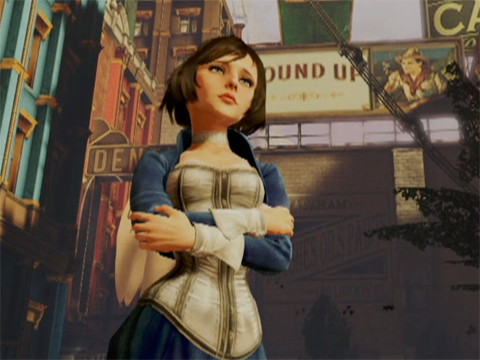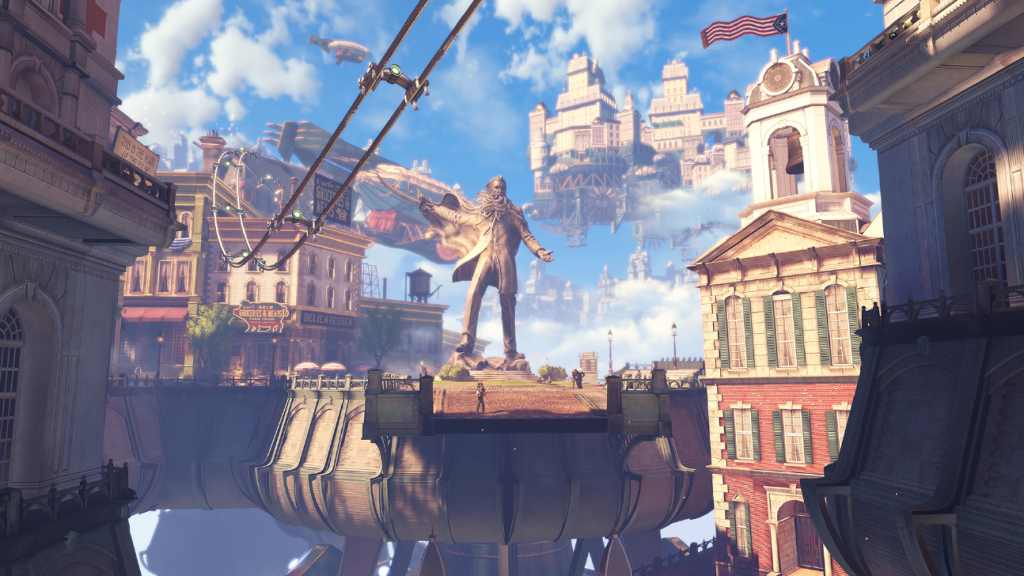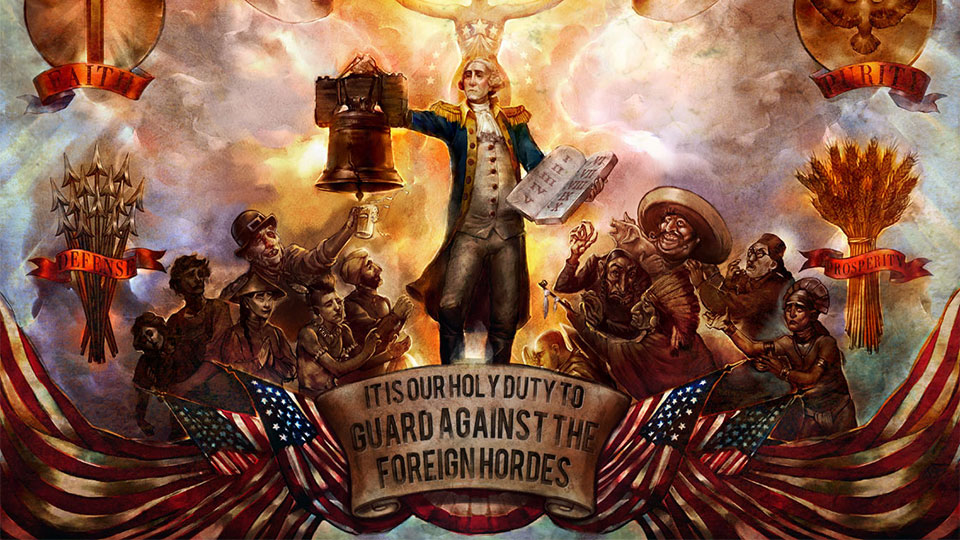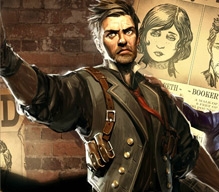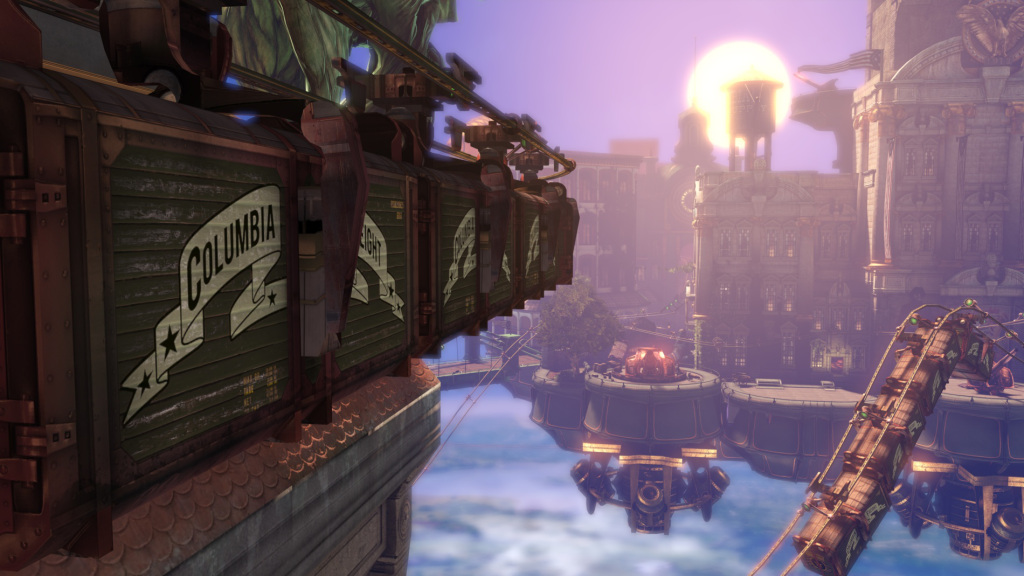This post has not been edited by the GamesBeat staff. Opinions by GamesBeat community writers do not necessarily reflect those of the staff.
A few days ago, 2K and Irrational Games released the official cover art for the upcoming Bioshock Infinite, a game over which I (and a considerable portion of the gaming populace) have been salivating for some time.
The general reaction to the cover has been one of disappointment, with complaints that the cover is "too generic" or "exactly the same as the cover for Uncharted from a different angle." Many folks have pointed to the fact that the cover seems to be the very embodiment of Mega 64's "Chin Down Eyes Up" sketch.
These complaints have merit, but I've also seen a fair amount of resigned shrugs from my fellow internet denizens. "Of course they're putting a grizzled white guy with a gun on the cover," people say. "It's what sells." 2K is obviously interested in their bottom line, and if they think they can get an extra couple hundred thousand copies sold by making the game look like Call of Duty or Uncharted, then they're going to go for it. We recognize this as symptomatic of a systemic problem with the gaming industry and gaming culture in general, and so while we don't especially like it, we at least understand it. It doesn't surprise us.
But it might worry us.
The fundamental reason that Bioshock Infinite's cover causes concern among gamers is that in advance of the game's release, we cannot say for sure how much this move toward appealing to the broadest possible audience (read: white, male) is purely a shift in marketing tactics, or whether it actually represents a step away from what made the original Bioshock such a unique and compelling experience.
Perhaps the best way to examine this is to take a look at what (and who) we're looking forward to seeing in the game–and why we're disappointed they haven't been given box art status.
Most obvious is the absence of Elizabeth, a character who compels many of us based only on what we've seen of her in trailers. The moment in this trailer in which Elizabeth takes Booker's hand and places it around her own throat as she makes him promise not to let the Songbird take her back into captivity is extremely compelling. We haven't been told very much about her origin, and we've gotten a glimpse of her mysterious (and really, if we're being serious, totally wicked) powers, so we're ready for her to be a big part of the game.
(As an aside: though Bioshock 2 did little to create much in the way of essential narrative, one of the things it did really well was build a relationship between the player's character, Subject Delta, and the non-playable Eleanor Lamb. Creating an emotional bond between the player and an NPC is no easy task, and even though the team that created Bioshock 2 isn't the same one that's working on Infinite, the chances of us caring deeply about Elizabeth by the end of the game's narrative seem pretty high. I care about her already. Did you hear her voice faltering in that trailer? Man.)
So Elizabeth's not on the cover, and that worries us. It shouldn't. Why? Elizabeth's on the back of the box, for starters, which shows that 2K isn't willing to hide her away entirely. It seems to be common practice in games marketing to de-emphasize female characters, which is kind of despicable but seems to be based on market data, even if it may well be a self-fulfilling prophecy. Does this make keeping Elizabeth off the cover a good idea, or even excusable? Absolutely not–but it makes it explicable, at least. At least they didn't stuff her in the bottom corner like they did Farah from Prince of Persia: Sands of Time. (She doesn't quite get the spread that Yuna does in FFX, either, but hey.)
Another thing that could well be on the cover but isn't is the city itself: Columbia. Both the original Bioshock and its immediate successor found success in no small part because of the world they built, Rapture, which remains one of the most detailed and haunting virtual environments a player can explore. Journeying through Rapture for the first (and to a lesser extent, the second) time was awesome–in the original sense of the word. It inspired awe in the player. At times, it was downright gut-wrenching.
The city of Columbia is immediately compelling to us because it appears at once wholly different from, and yet at the same time similar to, Rapture. Where Rapture is dark, Columbia is bright and dazzling. Where Rapture is close and confined, Columbia is open and enormous. And yet they are both obviously beautiful experiments that have been plunged into violence and grotesquerie. That's a part of the Bioshock formula–a part that we, as gamers, are anxious to return to. So why isn't it on the cover?
Well, it is. Sort of. There's an airship up in the left corner. It's kind of hard to see: there's a grizzled white man with a gun in the way, as well as some J.J. Abrams-style lens flare. Does this convey the sullied beauty and grandeur of Columbia? I don't think so.
And yet I don't think we need to worry about this. You could see Rapture in the background of the original Bioshock's cover, but not very clearly, and certainly not in a way that conveyed the epic scope of the ruined Utopia beneath the waves. It turns out that a setting isn't a great way to sell a game–and it certainly isn't the most logical choice for the cover. There's an argument to be made here for aping the covers of Bioshock and its sequel by making Songbird or one of the Heavy Hitters the center of attention, but I'm under the impression that 2K and Irrational are deliberately trying to separate themselves from that tradition to create a new identity for Infinite, and they're walking a fine line between trading on the Bioshock name and trying not to rehash too much of the formula that made the original(s) brilliant.
There's another part of the formula that's obviously present in Infinite, and that's the idea of anchoring the conflict within a particular philosophy–in the original Bioshock, this was Objectivism; in Infinite, it's American Exceptionalism. This is alluded to on the cover (the bit with the flag burning? Yeah, that's the allusion).
Is this part of the formula going to work as strongly in this outing? Is it possible to have an analogue to the exploration of player choice, morality, and agency that the first game employed? Are we going to get another "A man chooses; a slave obeys"? Call me naive, but I'm betting probably not. The first Bioshock dealt with matters that were implicitly intertwined with issues of control, freedom, and choice–perfect subjects to explore in an interactive medium like video games. The story, by necessity, required the protagonist to be an extension of the player–a silent protagonist was the obvious choice.
Booker DeWitt isn't a silent protagonist, and it's obvious that Irrational knows that if it's going to have a philosophically complex narrative, it's going to have to deal with different issues. I don't think we'll be able to know whether the narrative is as compelling or evocative as the first game's until we see the credits roll for ourselves.
And it's pretty hard to sell a video game by advertising its treatment of American Exceptionalism, anyway.
Which leaves us with Booker himself. Yes, he is definitely another grizzled white guy. With a gun.
To a certain extent, it makes sense to plaster his mug on the cover of the game, even if it's not a likeness that distinguishes him from Mr. Drake, or Mr. McGrath, or even Mr. Bellic or Mr. Miles. As the protagonist of a first-person shooter, we need to be able to envision Mr. DeWitt if we are to care about him as a character separate from us, the player. After all, in most first-person shooters, the character we're controlling is really more of a disembodied gun. Can a series go from having the protagonist be a non-entity to having them be an integral part of a compelling narrative?
Well, maybe. Jak II had a go at it, and it seemed to go over pretty well.
In my head, I am envisioning a conversation with the developers of the game that I hope (perhaps naively) is the reason we are getting the cover that we are. "We want the player to be familiar with Booker," says an individual in this hypothetical conversation. "Booker is such an integral part of this narrative, and it's important that we emphasize that."
I tell myself that this is the conversation that happened, because my initial reaction upon seeing the cover was quite the opposite. "Have you seen the numbers on this stuff?" someone says, in this version of the imaginary brainstorming session. "We'll sell ten million copies if we put a gruff white guy with a gun on the cover. Have you seen the numbers on Call of Duty?" (The numbers are very high.)
We cynical internet-goers immediately went here as soon as we saw the cover, and this is at the heart of our concern for this game we're anticipating so intensely. We think back to what we know of 2K Games and the rumors that have swirled around Infinite''s development, and we wonder: "If this cover is a calculated, low-risk stratagem meant to maximize sales… has this philosophy influenced the game design, and if so, to what extent?"
We bite our nails in anxiety because of what we've heard about the game's development: it's been pushed back several months (from October 2012 to February 2013), it has lost key developers (and gained others) toward the end of its development cycle, and we've been in a state of confusion about the game's multiplayer offering, which was going to exist, maybe, until it wasn't. A six-month delay and some staff turnover doesn't equate to "development hell," exactly, but it has certainly raised some eyebrows. Can a huge, high-profile game with an enormous development staff remain true to a unified vision when pressured by a publisher to appeal to the broadest possible audience and thus sell the maximum number of copies? Are these development hiccups indicative of a team struggling to find that unified vision?
Maybe. Maybe not. From the perspective of someone outside the gaming press, it's a little difficult to tell.
The multiplayer question, in particular, is tied to the issue of the developer's (and, more than likely, the publisher's) perception of its audience. On occasion, a series with a strong single-player offering will introduce a novel and worthwhile multiplayer conceit (as was the case with Assassin's Creed: Brotherhood, which introduced a kind of cat-and-mouse multiplayer that most players didn't even know they wanted, and is still pretty unique to the series). More often than not, however, a game with a strong single-player narrative will have multiplayer shoehorned into it in an attempt to boost sales. Sometimes this process is merely inoffensive, as was the case in Bioshock 2, a game whose multiplayer was not particularly compelling–but whose single-player campaign was neither hampered nor contradicted by it.
That wasn't the case with Spec Ops: The Line, whose multiplayer was not only tacked on but actively degraded the experience of the single-player campaign–and that's according to the guys who developed it! Spec Ops, a game with a dark, subversive narrative, was undermined by its publisher telling its developers that they needed multiplayer or they wouldn't sell as many copies. That publisher, by the way, was 2K Games.
So should we worry about this? Ultimately, I don't think we need to. As of a couple days ago, Ken Levine has confirmed that the game won't have multiplayer. That says a lot, actually–it says that Irrational Games has convinced 2K that the strength of the single-player experience will be enough to sell units. Levine is confident in his campaign. (Heck, the situation with Spec Ops might have convinced some folks at 2K that a bullet point on the back of the box isn't worth compromising their developers' vision–but maybe that's being a little optimistic.)
It's not just the willingness to go without multiplayer, however, that suggests that Irrational isn't compromising its vision. Levine's insistence on the inclusion of a "1999 Mode" indicates that the game is very much attuned to the kind of players who have been with him and his team since System Shock 2 (or at the very least, my friends who have insisted on playing the new XCOM on "Classic Ironman" mode in their first playthrough).
I don't know whether Bioshock Infinite is going to live up to the high standard set by its progenitor. I don't know if it will be able to create that lightning-in-a-bottle magic a second time. I think that, by virtue of the original's high pedigree, the odds are significant that we might be in for a minor–or even a major–letdown.
But for the moment, I'm not going to judge a game by its cover.
This post originally appeared on The Lost Levels.

